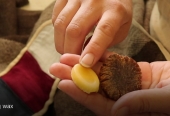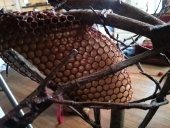
 1
1








Hugekultur; Beekeeping; Organic gardening; Vermiculture; Composting




find religion! church
kiva! hyvä! iloinen! pikkumaatila
get stung! beehives
be hospitable! host-a-hive
be antisocial! facespace

















find religion! church
kiva! hyvä! iloinen! pikkumaatila
get stung! beehives
be hospitable! host-a-hive
be antisocial! facespace








Jude Calhoun wrote:hay,
another beekeeper i know is having issues with his Langstroth hives, and i need to help him if i can. he sent me some photographs of the abandoned comb, which i've attatched below. i've got more photos if you'd like to look at them for more evidence of the issue.
in one hive, there seems to be a papery nest of some sort in the lower middle part of three frames. he hasn't seen any non-honeybee critters emerging from it. doesn't look like a wasp's nest, but maybze it's another bug? or some kind of mould??? we don't know when the bees ghosted, or when this nest thing appeared (so it could have been after they left or something)
the second hive, and this one I'm real nervous about, could be a virus of some kind that i haven't had personal experience identifying. when he opened the hive to check 'em, the bees were gone. even though they were a relatively new colony (about a year old), their comb was very dark. he is afraid it's American Foulbrood, and did the 'toothpick test' in some cells, but when he pulled the toothpick out of the cells, the tip wasn't brown or nasty or gooey. WHEW. So. what could it be?
He's located in Scranton, near Florence, South Carolina, and doesn't have much free time to be part of beekeeping groups down there, or be a mentee to any more experienced keepers.
ya'll were the first forum to come to mind when i thought about posing this question, and i felt it was high time i became part of the forums. also, it'd be real cool if i got a chance to receive a free copy of Christy Hemenway's book, The Thinking Beekeeper. cuz' i'm definitely thinking, and sharing those thoughts with novice bee enthusiasts (who are in turn sharing their strange thoughts with me) around richmond. there's a real movement buzzing here!
i'd appreciate any help with this, the dewd is becoming discouraged, and i don't want him to lose hope or give it up, cuz it's very very important to his mental/spiritual/everything wellbeing, and he's been having a tough go at it the last couple of years.
thanxx!
hi-5s & honey,
-jude


|
Looky! I'm being abducted by space aliens! Me and this tiny ad!
Homestead Pigs Course
https://permies.com/wiki/365748/Homestead-Pigs
|


